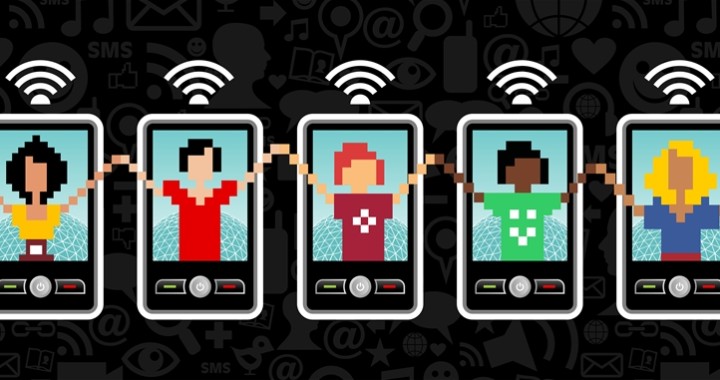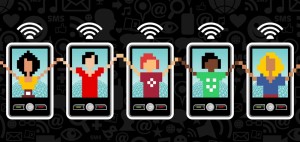So Sam what will youth work look like in 2013?
Think of the future and I know I always end up thinking about what gadgets we’ll be using, the new technology on the horizon. And I’m sure I’m not alone in this- teens with their unparalleled appetite for the new will be too. With the most accessible bit of tech for teens being their mobile phones (or cell phones) and with their love for them, we can be sure that they are keenly watching for what 2013 brings to phones. So if their eyes are on their phones and what new thing they will be able to do with them, should we be looking at what we can do with them, with their phones in our youth work in 2013?
Teens and their phones
Teen ownership rates are continually rising with a 2012 American study showing that 23% of 12 to 17 year olds own a smartphone and another 54% owning a regular cell phone. Every day 68% of teens text, 51% visit social networking sites and 11% send or receive tweets (Common Sense Media 2012).
It probably goes without saying that in 2013 even more teens will be in possession of a mobile and will be using them to text, tweet or do whatever the latest thing is. But why should we as youth workers care about this?
More and more teachers and youth workers are adapting their work to embrace the teen love affair with their phones, rather than trying (and failing) to get them to switch them off. This is a trend that is bound to continue in 2013.
The social TV or ‘second screen’ concept is increasingly being used in sessions to change phones from being a source of distraction to a tool of engagement. So rather than young people using their phones to keep up with what is going on outside the session, they are being used to stimulate conversation on the session. So while watching something on a screen or watching a live in-person talk or presentation, young people are invited to submit opinions, questions and comments either by text or submitted on Twitter via hash tag to feed later discussion. This works really well to keep them on-topic, to get the verbally quieter ones contributing and to generally spark off debate.
‘Flash research’ is another application for phones in sessions. In the first ten minutes, groups go off and research the net, or text people they know to find information on a topic. So instead of youth workers bringing the ‘facts’ to the session (which always brings out the sceptic), young people show us what is relevant and important to them. This is hugely empowering for them as they feel they have a real voice and that a worker’s view or presentation of ‘facts’ doesn’t automatically trump theirs. The fact that they get to use their beloved phones also means that what might have been a relatively boring brainstorming exercise before becomes something of interest to them.
These are just two of many examples of using mobiles in youth work. The embracing of cell/mobile phones in youth work sessions is bound to continue and expand in 2013, probably in ways which we don’t even realise yet. If we fail to keep up, we do run the risk of offering sessions which do not maximise teen engagementas they lack the cultural relevance which is so important to teens, and they could walk away, declaring us out-of-touch dinosaurs.
Timeless ‘tones
However, when looking to the future, when trying to predict and stay abreast of change we always need to be careful not to lose sight of what is really important, the stuff that is at the core of our work. We should never forget the timeless qualities that outlast trends and changes in popular culture and that keep our work relevant whatever medium we use to deliver our message.
So in 2013, even with the expansion of mobile interaction, quality youth work should look very much like it has done in the past.
Relationship, not just interaction, will be key.
Social networking and technical gadgetry have been accused of causing an increase in interaction but a decline in real communication. While there are elements of truth to this, technology when used well, can enhance rather than degrade our communication with youth. It can complement what any good youth worker knows lies at the heart of good youth work- human connection of the face-to-face kind. Research shows that despite all the technological advances and the increased ownership of mobile technology, teens preferred method of communication is face-to-face.
So while youth work will involve more technical wizardry in 2013 we should also allow time and space for unmediated humanconnection. Particularly for those youth who are struggling with lack of personal connection with family members and other professionals, direct human engagement rather than technologically-mediated interaction can be vital.
And if our focus is on relationship it will mean that no-one gets left behind due to lack of ownership of the latest device (23% of teens do not have a cell phone at all). We will be mindful of trying to connect with everyone, whatever their circumstance, in the way that they need.
Helping our teens to think and communicate well will be at the heart of helping them succeed.
With the continual rise of texting, social networking and social TV in teens’ lives in 2013 it will become ever easier to shoot off opinions and statements with relatively little thought or reflection – their fingers often operating faster than their minds – and this can work against good thinking, good decision-making and good communication.
So we need to ensure that even when using the latest tools in our work, that we don’t get slack in helping them think and communicate well. We need to show them that text messaging and social media can be great conversation starters and can be a great way to get us thinking, but if we are to really communicate we will need to take more time to formulate opinions, to express them well, to really listen to others respectfully and to reflect, and that most of the time this happens when we actually take the time to really talk to people. Our sessions should never get carried away on a technological wave that forgets the core skills we need to help them develop if they are to successfully navigate through life.
So while 2013 may be technologically more advanced and our ways of connecting and engaging may expand we shouldn’t forget that good youth work was the same in the past as it is today and will be tomorrow. We need to keep mobile and current with our methods but always ensuring we have a strong signal from the good youth work base-station. No signal, no useful service. It was true in 2012 and will still be true in 2013 and beyond.
Bio:
 Sam Ross, popularly known as the ‘Teenage Whisperer’ is an expert in connecting with and helping the most challenging, disengaged and troubled teens to turn their lives around. She has worked in both educational and youth justice settings, both with young people and their parents or carers. Really understanding teens is the beginning, middle and end of her work and she helps professionals and parents achieve this through her website, providing advice, insight and resources: www.teenagewhisperer.co.uk You can also connect with her on Twitter: @Teen_Whisperer or Facebook: http://www.facebook.com/teenagewhisperer
Sam Ross, popularly known as the ‘Teenage Whisperer’ is an expert in connecting with and helping the most challenging, disengaged and troubled teens to turn their lives around. She has worked in both educational and youth justice settings, both with young people and their parents or carers. Really understanding teens is the beginning, middle and end of her work and she helps professionals and parents achieve this through her website, providing advice, insight and resources: www.teenagewhisperer.co.uk You can also connect with her on Twitter: @Teen_Whisperer or Facebook: http://www.facebook.com/teenagewhisperer 





